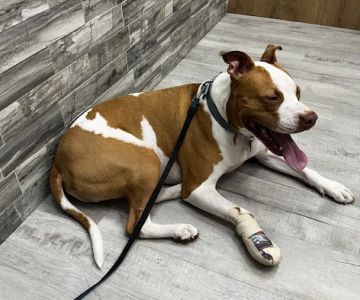How to Care for Your Pet’s Paws and Nails Properly
As a proud pet owner, one of the most important aspects of my pet's health that I initially overlooked was paw and nail care. Over time, I realized that taking proper care of your pet’s paws and nails is not only crucial for their comfort but also for their overall health and well-being. If you're like me and looking to ensure your furry friend stays healthy and happy, it’s essential to understand how to properly care for their paws and nails. In this article, I’ll share everything I’ve learned about paw and nail care for pets, from the basics to more advanced techniques, and the vital role this care plays in preventing injuries and promoting a comfortable life for your pet.
1. Why Paw and Nail Care Are Important
Initially, I didn’t realize how much of an impact paw and nail care had on my pet’s quality of life. For dogs and cats alike, paws are crucial for mobility, balance, and overall comfort. Regular nail trimming and paw maintenance can help avoid painful conditions such as ingrown nails, infections, or abrasions. I learned firsthand that taking care of your pet’s paws is just as important as feeding them well and keeping them active. It became evident when I saw how much my dog struggled with walking on rough or hot surfaces after I neglected their paw pads for a while.
Paw pads and nails are also subject to wear and tear, and keeping them healthy can prevent unnecessary pain or injury. Additionally, nails that are too long can cause pets to walk awkwardly, leading to other musculoskeletal problems. Nail care is a simple yet essential aspect of pet health that can help prevent complications in the future.

253 Hurffville - Cross Keys Rd #5b, Sewell, NJ 08080, USA
See Details1.1 Common Problems Caused by Poor Paw and Nail Care
I noticed that when I didn’t properly care for my pet’s nails, they developed painful conditions like split or cracked nails, and their paws became sore and tender. Long nails can also curve into the skin, causing ingrown nails, which can be extremely painful and lead to infections. Moreover, rough, cracked paw pads are more susceptible to environmental factors, such as salt or chemicals on roads during the winter. These problems can quickly lead to more significant health issues if left untreated.
2. How to Properly Care for Your Pet's Paws
Proper paw care is not just about trimming nails; it involves keeping the paws clean, moisturized, and protected from external hazards. Here are some essential tips I use to ensure my pet’s paws stay healthy:
2.1 Regular Paw Inspection
I make it a habit to regularly check my pet’s paws for any signs of injury, cuts, or infections. Pet paws can collect dirt, debris, and even tiny stones, especially after walks in the park or on rough surfaces. By checking my pet’s paws after each walk, I ensure that there is no trapped debris that could cause irritation. Additionally, keeping an eye on the paw pads can help catch any issues early on, such as infections or the development of corns or calluses. Regular inspections have helped me avoid unnecessary discomfort for my pets, and I highly recommend adding this to your routine.
2.2 Cleaning and Moisturizing Paw Pads
When I first started caring for my pet’s paws, I learned that paw pads can dry out and crack, especially during extreme weather conditions like winter or summer. To help maintain moisture, I use a pet-safe paw balm to keep the pads soft and hydrated. Cleaning the paws with a gentle pet wipe after walks also helps remove dirt and salt that could cause irritation. By moisturizing the paw pads, I noticed my pet seemed more comfortable, and there was less wear and tear on the paws overall.
2.3 Protecting Paws from Hot and Cold Surfaces
One of the most important lessons I learned in paw care is the danger of hot surfaces in the summer and cold, salty roads in the winter. My dog used to resist walking on hot pavement, and I realized it was because the surface was burning his sensitive paw pads. I started using protective booties during walks in the summer to avoid this issue. Similarly, in the winter, I make sure to wipe my pet’s paws thoroughly after walking outside to remove salt or other harmful chemicals. These simple steps have helped prevent discomfort and protect my pet’s paws from environmental damage.
3. Nail Care: How to Trim Your Pet's Nails
Trimming your pet’s nails is another essential aspect of overall paw care. While many pets hate getting their nails trimmed, it’s crucial for their health and comfort. For a long time, I was apprehensive about trimming my dog’s nails, worried that I might cut them too short or cause bleeding. After a few visits to the vet for professional nail trims, I learned how to properly trim them myself, and it’s now a regular part of my pet care routine. Here’s how I do it:
3.1 Understanding When to Trim
The first thing I learned is how to gauge when my pet’s nails need trimming. If I hear their nails clicking on the floor, it’s definitely time for a trim. Additionally, if their nails start to curl or grow into the paw pads, it’s crucial to trim them immediately to avoid causing pain. The general rule is that the nails should never be longer than the pads of their paws, and they should never be allowed to grow so long that they interfere with walking or cause discomfort.
3.2 Tools for Nail Trimming
To trim my pet’s nails, I use a high-quality nail clipper designed specifically for pets. I also keep styptic powder on hand just in case I accidentally cut too close to the quick, which can cause bleeding. I’ve found that a quiet, non-threatening environment is key to helping my pet feel relaxed during the process. It's important to start slow, and sometimes I take breaks to prevent stressing out my pet. Over time, with patience and practice, I’ve become more confident in trimming my pet’s nails myself.
3.3 Seeking Professional Help
If you’re not comfortable trimming your pet’s nails yourself, or if your pet has particularly sensitive paws, it’s always a good idea to seek professional help. Many groomers and veterinary offices offer nail trimming services. I’ve found that regular visits to the vet or groomer for nail trims help keep my pet’s nails in check and avoid potential complications. Some pets may also benefit from a professional pedicure to ensure that the nails are trimmed properly and safely.
4. Preventing and Treating Common Paw and Nail Problems
Throughout my journey of caring for my pet’s paws and nails, I’ve encountered a few common issues. Here’s how I’ve tackled them:
4.1 Cracked or Dry Paw Pads
If you notice your pet’s paw pads are cracked or dry, a soothing paw balm can work wonders. I found that regular moisturizing and protecting the paws from extreme weather conditions help prevent these issues from occurring. If the cracks seem severe or are accompanied by redness or swelling, it’s important to consult a veterinarian to rule out infection.
4.2 Ingrown Nails
Ingrown nails can be painful and lead to infections. If you notice your pet’s nails curling into the skin or becoming red and swollen, it's crucial to trim the nails carefully or take them to a professional. I’ve learned that frequent nail trimming and regular inspections help prevent this condition from happening.
5. Conclusion: Keeping Your Pet's Paws and Nails Healthy
Taking care of your pet’s paws and nails is a simple but incredibly important part of their overall health and well-being. By regularly inspecting the paws, moisturizing the pads, trimming the nails, and providing protection from harmful surfaces, you can ensure your pet remains comfortable and pain-free. If you’re unsure how to care for your pet’s paws and nails, don’t hesitate to ask your veterinarian for advice or visit a professional groomer. Healthy paws and nails contribute to your pet’s mobility, comfort, and happiness, and the effort you put into caring for them is worth every moment.
For expert advice and professional grooming services, visit Hidden Brook Veterinary for the best paw and nail care options for your pet.










